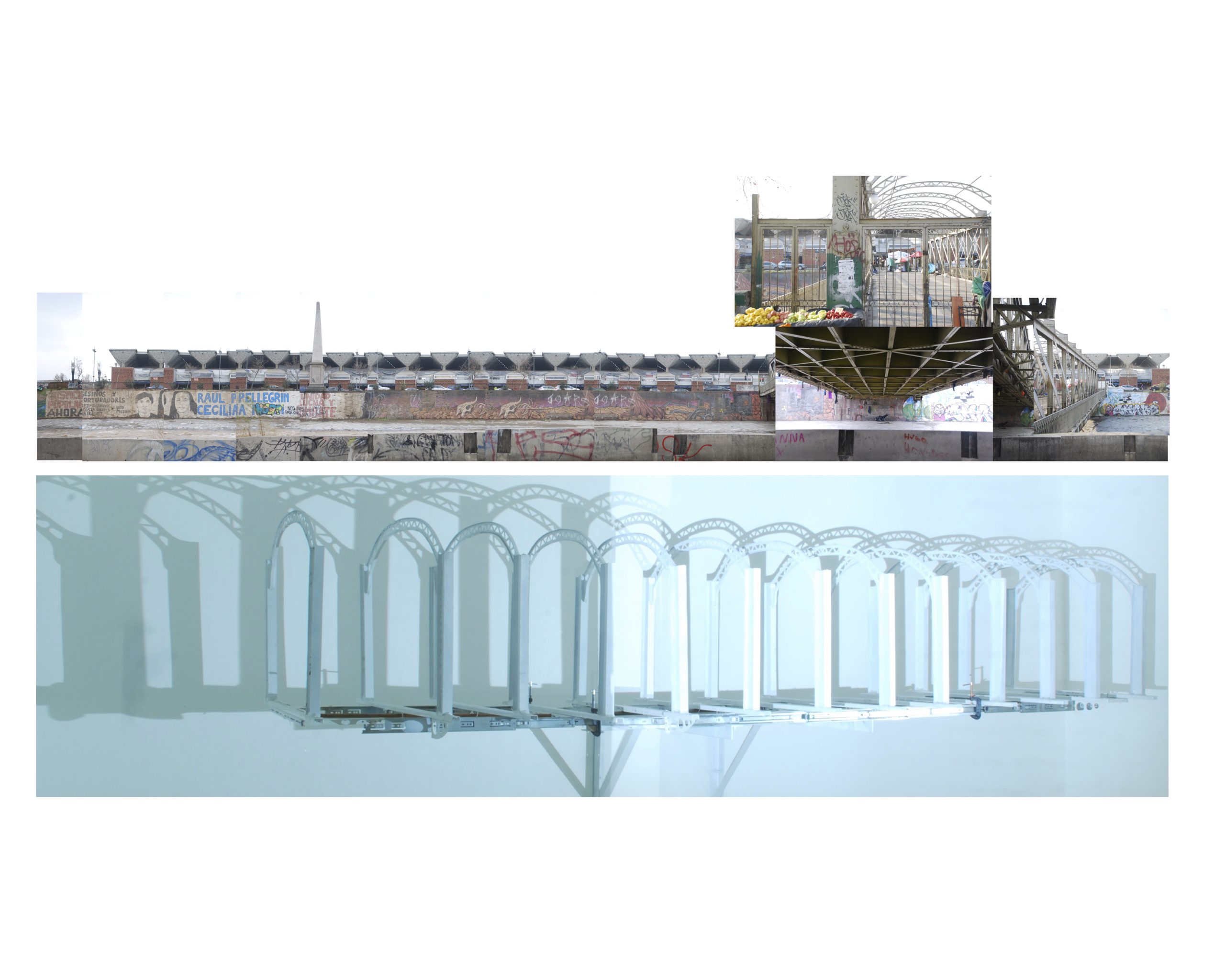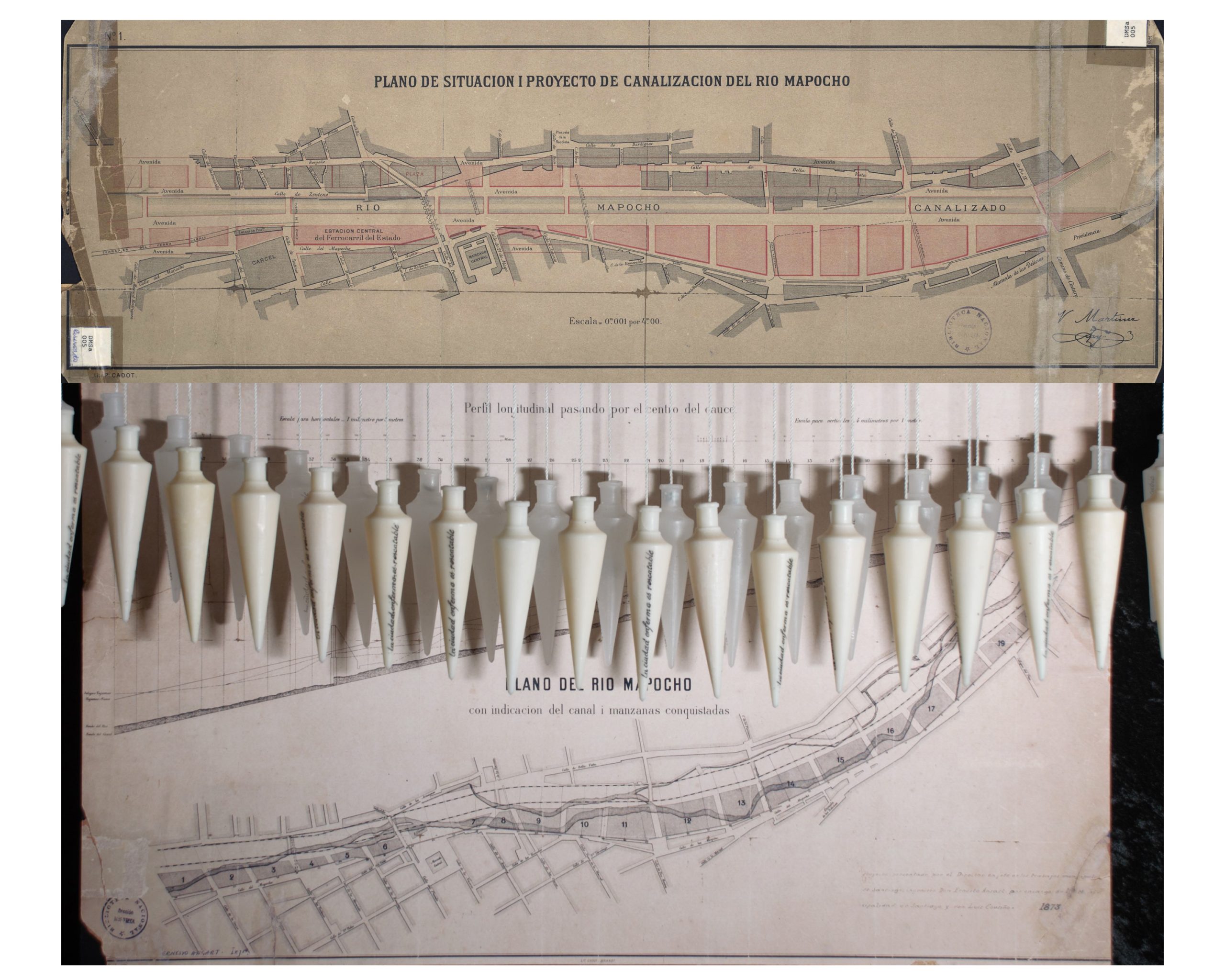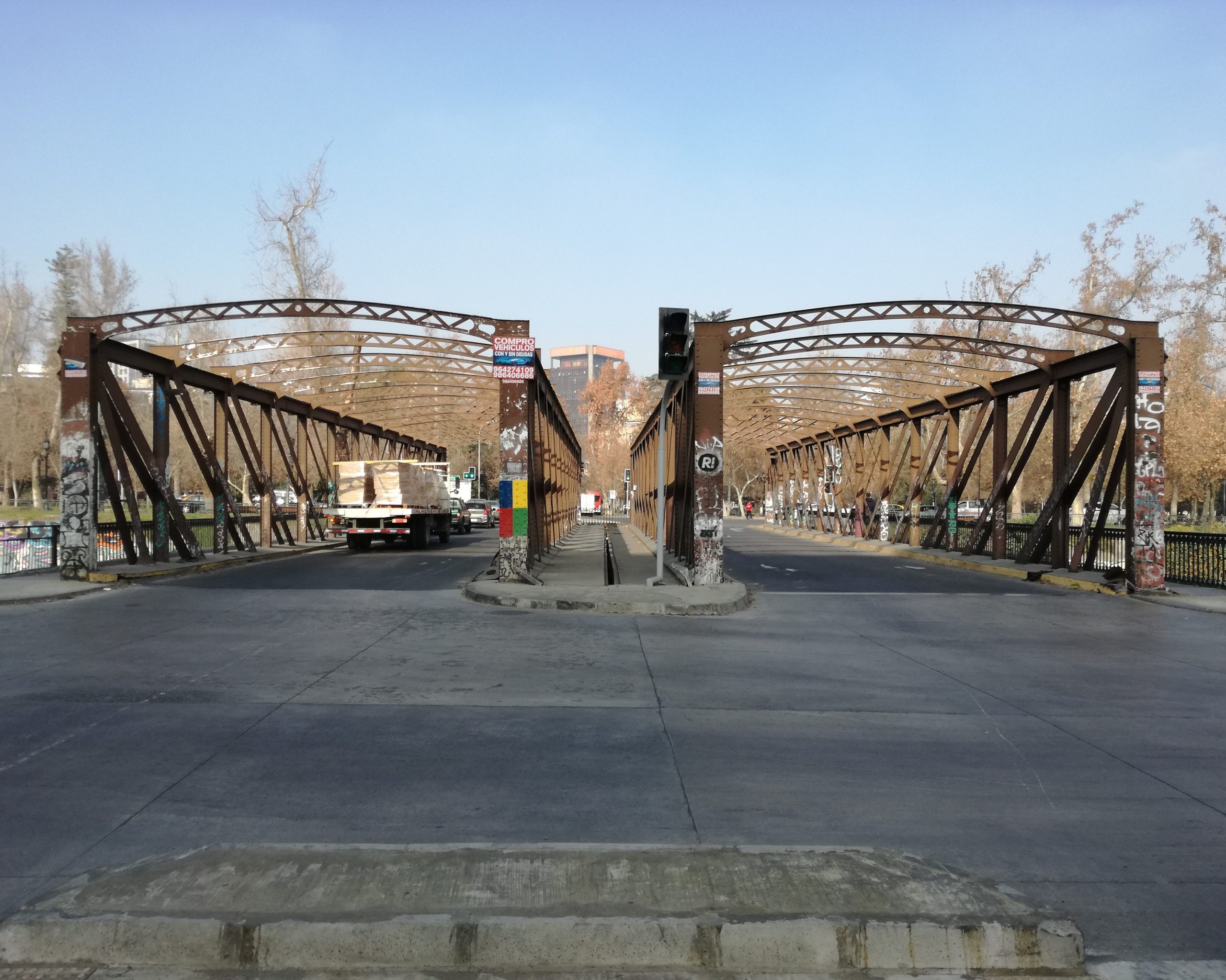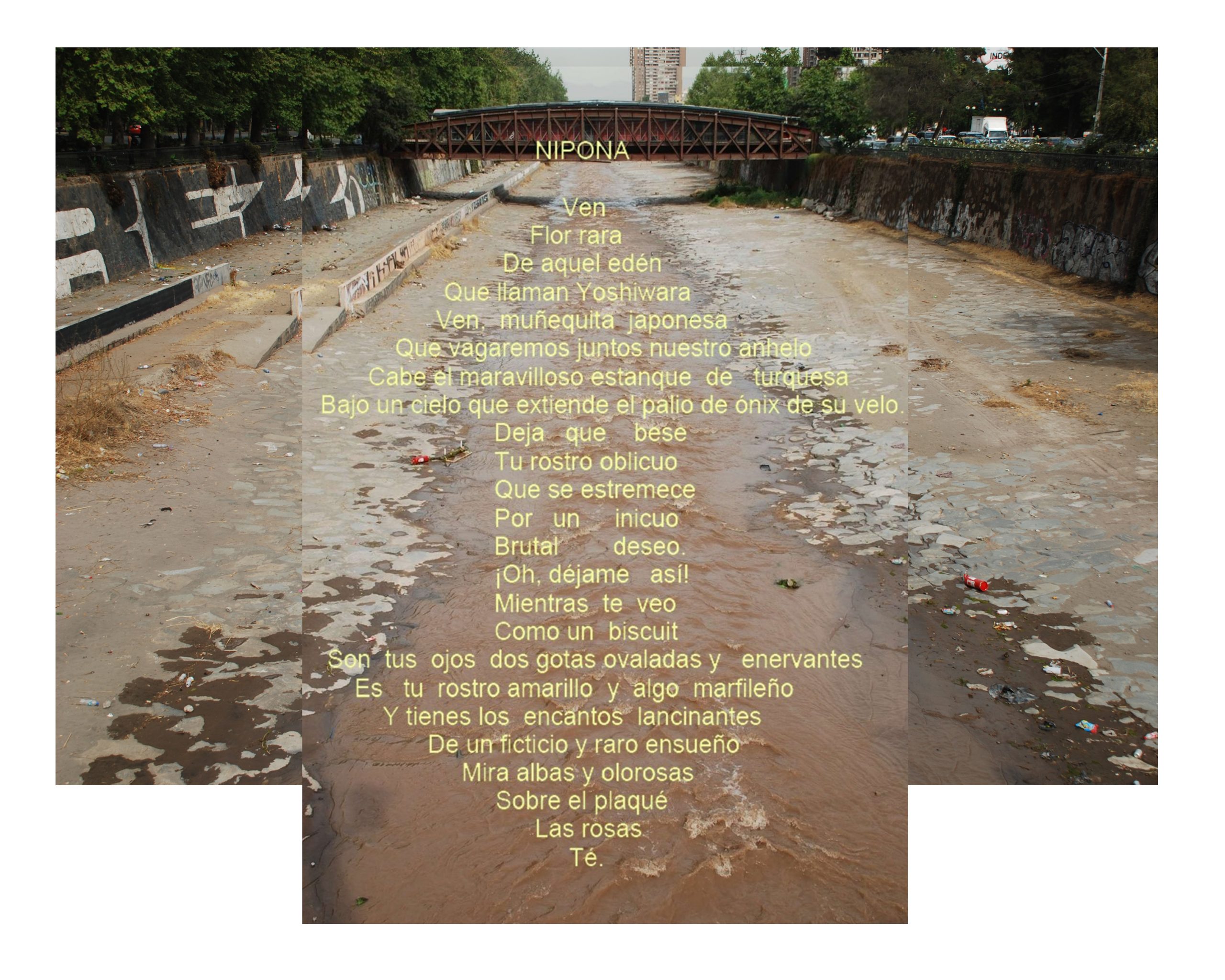
Image 1: Puente Los Carros AKA 21 de Mayo, 2017. Collage of the site and photograph of a prototype scaled, kinetic model of this bridge, the model is 85 cm x 68 cm by varying dimensions as it expands (4.2) m and contracts (2.4m). Composite image, photograph and model by Anthony McInneny.
“The bridge is a work of art and symbol; it is a pragmatic and concrete illustration of nature transitioning into culture” (Augé 2014, 10-12)

Image 2: La Ciudad Enferma es Rescatable (The Sick City Can be Saved), 2016. A quote attributed to the Mayor of Santiago, Benjamín Vicuña Mackenna (1875). Cast plumb bobs, inscribed with this quote suspended in front of two historical engineering plans. Below, Ernesto Ansart, engineer of Vicuña Mackenna, and his plan for the canalization (1873). Above, Engineer Martinez’s final design (1885) indicating the position of the nine metal bridges. Composite image and plumb bobs by Anthony McInneny.
A series of 9 Meccano type bridges were installed during the late 19 C as part of the canalization of the Mapocho River (Image 2). The canal and its bridges were the centerpiece of the modernization of Santiago de Chile as the “Paris of South America” and linked the north and south sides of the city for three kilometers. These links were easily moved or removed, replaced and multiplied during the 20 C. In the 21 C, three sites along the Mapocho contain the remaining four metal crossways.
“Here is a thing that I call art, but I didn’t even make it myself.” As we know, “art,” etymologically speaking, means “to hand make.” (Duchamp 1959, 18)
The assemble metal brides have been appropriated, demounted and re-arranged as heritage objects of anywhere within the river’s pre modern, early modern and contemporary urban history.
“Appropriation itself implies time (or times), rhythm (or rhythms), symbols and a practice”. (Lefebvre 1991, 356)
The project investigates the bridge as a metaphor of communication – of language and physical movement in the specific context of Santiago’s urban culture.

Image 3: Twin Sisters, 2019. Digital Photograph of the two bridges, Purisima and Loreto. Photograph by Anthony McInneny
Research Methods:
- Ignacio Solas-Morales’ Terrain Vague (Morales 2013, 24-30). A complicit preservation of disuse or abandonment.
- James Meyers’ The Functional Site. (Meyer 2000, 23-37). From literal site specificity to the functional site of the derive.
- Henri Lefebvre’s Spatial Triad. Representations of Space, Spaces of representation and Spatial practice. (Lefebvre 1991). Appropriation and re-appropriation of space through use.
Project/site/intervention/dates:
- Puente (Bridge) Los Carros is, in the public imaginary, a transitional structure of the historical and modern capital city transforming from the 19C 21 de Mayo wooden bridge for carts, to this metal bridge for the 20C tram and later for the 21C pedestrian. It is closed due to structural damage from the 2010 earthquake. It is the disused, decaying status of this collapsible historical artefact that is the subject of intervention. June 1 2020. (Image 1).
- Twin Sisters. Puente Loreto was moved during the Dictatorship, next to its twin, Puente de la Purisima. The two identical bridges, now in one location were made and assembled by a Chilean company Lever, Murphy and Co in the port city of Valparaiso, some 100 kilometers from Santiago. The intervention in these bridges will concern movement, force and the mistaken identity of identical things. June- September 2020. (Image 3).
- Pius Poet. Puente Vicente Huidobro was made by the French engineering company Schneider-Creusot. Vicente Huidobro was a Chilean Avant guard poet who collaborated with Apollinaire. The bridge was better known as Puente Pio Nono, after Pope Pius IX, but is not where it used to be. It is 300 meters downstream and is a theatre. Huidobro’s replacement is a heritage replica known by this nickname which means – Poppa Pope. Puente Huidobro, the bridge, cannot be crossed and is never called by its name. The intervention between the original site and the original bridge is based in one of Huidobro’s concrete poems, Nipona. Sept- October 2020.

Image 4: Puente Poem Vicente Huidobro. Digital Photograph and composite image with poem. Poem text and form, Nipona, by Vicente Garcia-Huidobro. Photograph and composite image by Anthony McInneny
Project Team:
Anthony McInneny (PhD Architecture. RMIT University, Australia) Conjoint Professor University of Newcastle, Member of RMIT University CAST. Lead Artist/Investigator
Beatriz Maturana Cossio (PhD Architecture. University of Melbourne). Associate Professor Faculty of Architecture and Urbanism, University of Chile, Santiago. Adjunct Professor RMIT University. Urban Design and Heritage Advisor
Museo Benjamín Vicuña Mackenna, (Museum of the City), Santiago, Chile. Institutional partner and archive resources.
Bibliography:
Augé, Marc. 2014. “The Symbolism of the Bridge.” In: Of Bridges and Borders Vol. II, Edited by Sigismond De Vajay. 10-12 JRP | Ringier
Duchamp, Marcel. 1959. A 1959 Interview with Marcel Duchamp: The Fallacy of Art History and the Death of Art by George Heard Hamilton. Reproduced in Artspace 2018.
Lefebvre, Henri. 1991. The Production of Space. Oxford, OX, UK; Cambridge, Mass, USA: Blackwell
Sola-Morales, Ignacio de. 2013. “Terrain Vague”. In Terrain Vague Interstices at the Edge of the Pale, edited by Patrick Barron and Manuela Mariani, 24-30, Routledge
Meyer, James. 2000. The Functional Site; or, The Transformation of Site Specificity. In Space, site, intervention: situating installation art, edited by Erika Suderburg, 23-37, University of Minnesota.




